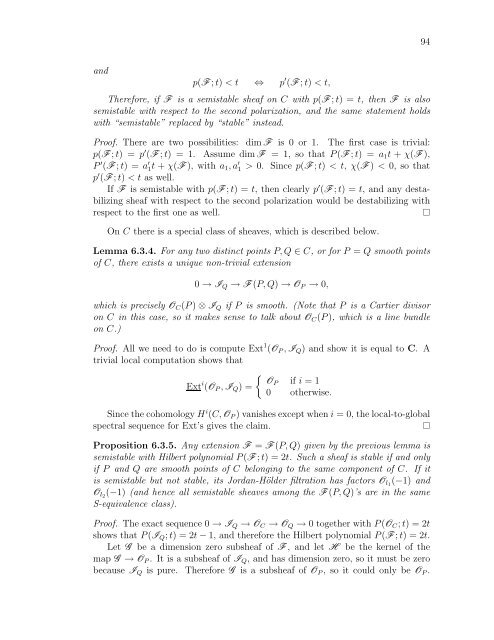derived categories of twisted sheaves on calabi-yau manifolds
derived categories of twisted sheaves on calabi-yau manifolds
derived categories of twisted sheaves on calabi-yau manifolds
Create successful ePaper yourself
Turn your PDF publications into a flip-book with our unique Google optimized e-Paper software.
and<br />
p(F ; t) < t ⇔ p ′ (F ; t) < t,<br />
Therefore, if F is a semistable sheaf <strong>on</strong> C with p(F ; t) = t, then F is also<br />
semistable with respect to the sec<strong>on</strong>d polarizati<strong>on</strong>, and the same statement holds<br />
with “semistable” replaced by “stable” instead.<br />
Pro<str<strong>on</strong>g>of</str<strong>on</strong>g>. There are two possibilities: dim F is 0 or 1. The first case is trivial:<br />
p(F ; t) = p ′ (F ; t) = 1. Assume dim F = 1, so that P (F ; t) = a1t + χ(F ),<br />
P ′ (F ; t) = a ′ 1t + χ(F ), with a1, a ′ 1 > 0. Since p(F ; t) < t, χ(F ) < 0, so that<br />
p ′ (F ; t) < t as well.<br />
If F is semistable with p(F ; t) = t, then clearly p ′ (F ; t) = t, and any destabilizing<br />
sheaf with respect to the sec<strong>on</strong>d polarizati<strong>on</strong> would be destabilizing with<br />
respect to the first <strong>on</strong>e as well.<br />
On C there is a special class <str<strong>on</strong>g>of</str<strong>on</strong>g> <str<strong>on</strong>g>sheaves</str<strong>on</strong>g>, which is described below.<br />
Lemma 6.3.4. For any two distinct points P, Q ∈ C, or for P = Q smooth points<br />
<str<strong>on</strong>g>of</str<strong>on</strong>g> C, there exists a unique n<strong>on</strong>-trivial extensi<strong>on</strong><br />
0 → IQ → F (P, Q) → OP → 0,<br />
which is precisely OC(P ) ⊗ IQ if P is smooth. (Note that P is a Cartier divisor<br />
<strong>on</strong> C in this case, so it makes sense to talk about OC(P ), which is a line bundle<br />
<strong>on</strong> C.)<br />
Pro<str<strong>on</strong>g>of</str<strong>on</strong>g>. All we need to do is compute Ext 1 (OP , IQ) and show it is equal to C. A<br />
trivial local computati<strong>on</strong> shows that<br />
Ext i <br />
OP if i = 1<br />
(OP , IQ) =<br />
0 otherwise.<br />
Since the cohomology H i (C, OP ) vanishes except when i = 0, the local-to-global<br />
spectral sequence for Ext’s gives the claim.<br />
Propositi<strong>on</strong> 6.3.5. Any extensi<strong>on</strong> F = F (P, Q) given by the previous lemma is<br />
semistable with Hilbert polynomial P (F ; t) = 2t. Such a sheaf is stable if and <strong>on</strong>ly<br />
if P and Q are smooth points <str<strong>on</strong>g>of</str<strong>on</strong>g> C bel<strong>on</strong>ging to the same comp<strong>on</strong>ent <str<strong>on</strong>g>of</str<strong>on</strong>g> C. If it<br />
is semistable but not stable, its Jordan-Hölder filtrati<strong>on</strong> has factors Ol1(−1) and<br />
Ol2(−1) (and hence all semistable <str<strong>on</strong>g>sheaves</str<strong>on</strong>g> am<strong>on</strong>g the F (P, Q)’s are in the same<br />
S-equivalence class).<br />
Pro<str<strong>on</strong>g>of</str<strong>on</strong>g>. The exact sequence 0 → IQ → OC → OQ → 0 together with P (OC; t) = 2t<br />
shows that P (IQ; t) = 2t − 1, and therefore the Hilbert polynomial P (F ; t) = 2t.<br />
Let G be a dimensi<strong>on</strong> zero subsheaf <str<strong>on</strong>g>of</str<strong>on</strong>g> F , and let H be the kernel <str<strong>on</strong>g>of</str<strong>on</strong>g> the<br />
map G → OP . It is a subsheaf <str<strong>on</strong>g>of</str<strong>on</strong>g> IQ, and has dimensi<strong>on</strong> zero, so it must be zero<br />
because IQ is pure. Therefore G is a subsheaf <str<strong>on</strong>g>of</str<strong>on</strong>g> OP , so it could <strong>on</strong>ly be OP .<br />
94
















